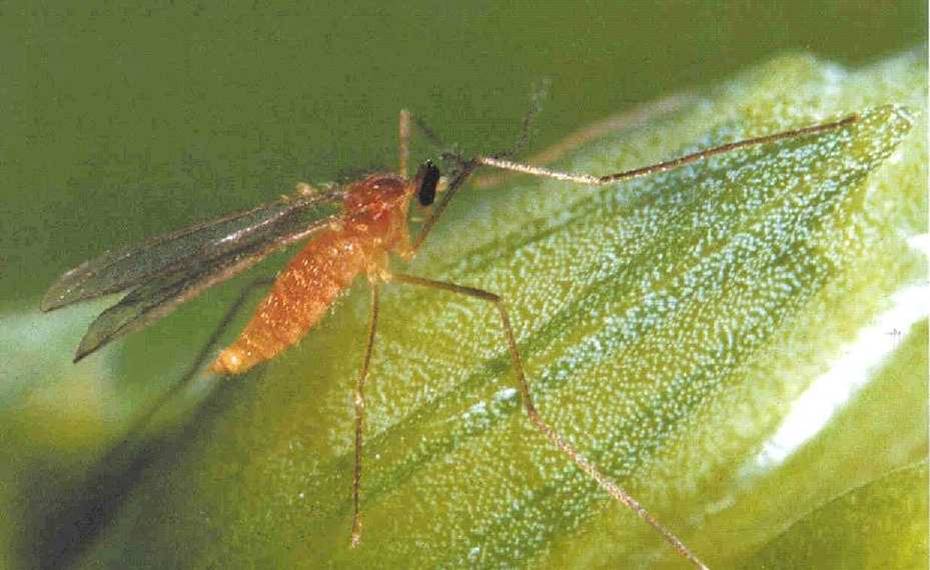
Wet soils and temperatures above 15 celcius will favour Wheat Blossom midge pupation, a pest that damages yield, reduces grain quality and encourages secondary fungal infections.
Crops this year may be particularly prone to attack if a warm spell kicks off pupation, whilst crops are still backward.
As in previous years, Dow AgroSciences have started their Pestwatch service to provide farmers with the best indication of risk.
Pestwatch has monitored Orange Wheat Blossom midge populations at 15 sites across the UK. The average population in this years sampling is 1.8 per kg of soil, which is the lowest since 2004.
There is some variation between sites, with populations at Shropshire being at a level that could cause significant damage and indicating the need for close monitoring of individual crops. The start of pupation has been detected in Suffolk. Yellow Wheat Blossom midges were recorded at 60% of sites.
Sarah Hurry of Dow AgroSciences explains that Orange Wheat blossom midge larvae cause most damage by feeding on developing grain.
"Damage occurs when egg laying coincides with the vulnerable growth stages of the crop (GS 53-59), or slightly earlier for Yellow Blossom midge (GS51-55). Orange Wheat Blossom midge larvae overwinter in cocoons and require certain conditions (70 days with temperatures less than 10 celcius) to break diapause, when larvae move towards the soil surface. They require sufficient rainfall and a rise in soil temperatures to above 13°C to stimulate pupation."
Adult midges live for around 7 days and each female adult can lay around 80 eggs mid-way through this time on emerging ears, between GS53 and GS39.
Eggs will hatch in 4-10 days and emerged larvae feed on developing grain within the floret for 2-3 weeks. Once the larvae have entered the glume, they are protected from chemical applications, so it is important to act quickly once thresholds are reached.
"Susceptible sites are those wheat fields where the pest was noted last year, especially if no treatment was carried out. Consider using traps at these sites. Some wheat varieties are resistant and won’t need monitoring. When there are one or more adults per six ears in wheat crops for seed or milling, or one or more adults per three ears in wheat crops intended for feed, treatment is advised. As adults fly mostly during warm still evenings, this is the best time to monitor pest levels," she said.
Sarah Hurry advises that if chemical treatment is justified by thresholds being met or exceeded, growers should use Dursban WG at 0.6 kg/ha in 200 to 1000 litres of water without delay.
"Dursban WG will control all the life stages of the pest, giving growers the widest window of opportunity and more flexibility to control this damaging pest."
"Dursban WG gives effective knockdown of adult midges, effective control of 7 to 10 days to control further flights of adults plus vapour action to control larvae emerging from eggs laid by the first flight of adults. Pyrethroids and other alternatives will only reduce adult midge populations and will not control larval populations. They are only persistent for two days post-application."
"All major groups of insecticides pose a potential risk to beneficial insects when sprayed during the summer. Precautions should be taken to minimise impact against wildlife by applying an effective insecticide only when necessary."
"In order to allow an area for beneficial arthropods to survive and colonise the field, growers should comply with the Stewardship ’Say No to Drift’ guidelines, including adopting a 20 metre no-spray buffer zone beside watercourses and by using LERAP three-star low-drift nozzles and adopting a 12m no-spray buffer zone beside hedges or grass strips. The new Stewardship ’Say NO to drift’ initiative aims to support the future availability and use of insecticides containing chlorpyrifos.
Orange Wheat Blossom midge can cause substantial loss of yield and quality. Typically one larvae feeding per grain site can cause about 30% yield loss; with two or three larvae per grain site loss can be as much as 75%, or even higher if ear emergence is late. In addition larval feeding can induce premature sprouting in the ear and a reduction in Hagberg Falling Number. Secondary fungal attack can follow under damp conditions.
